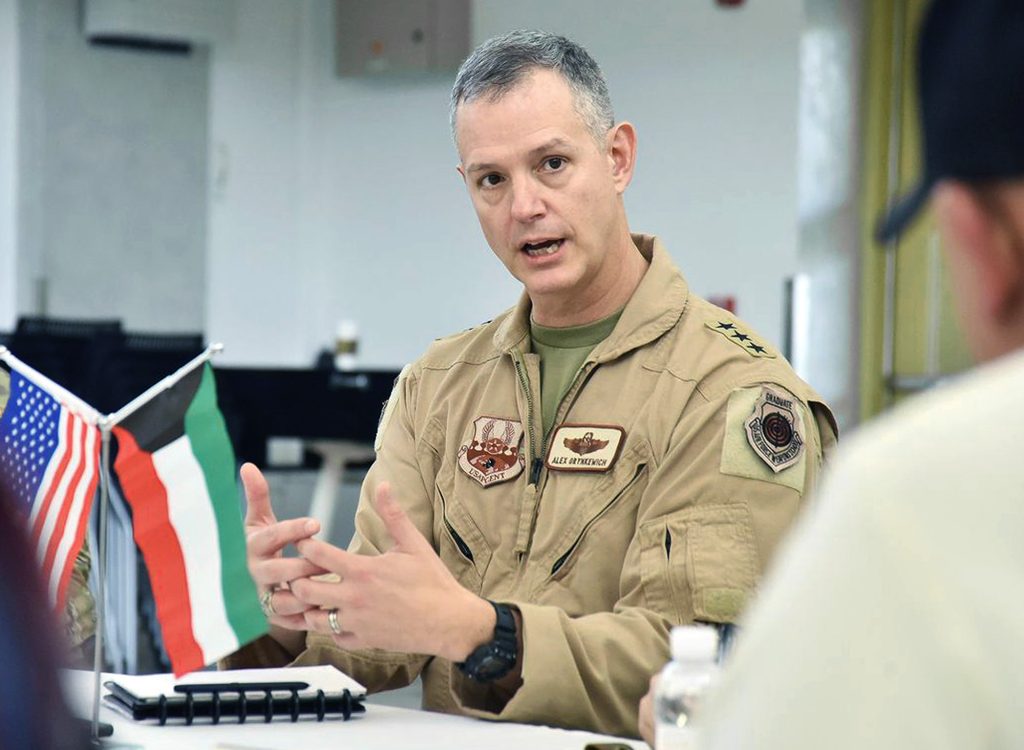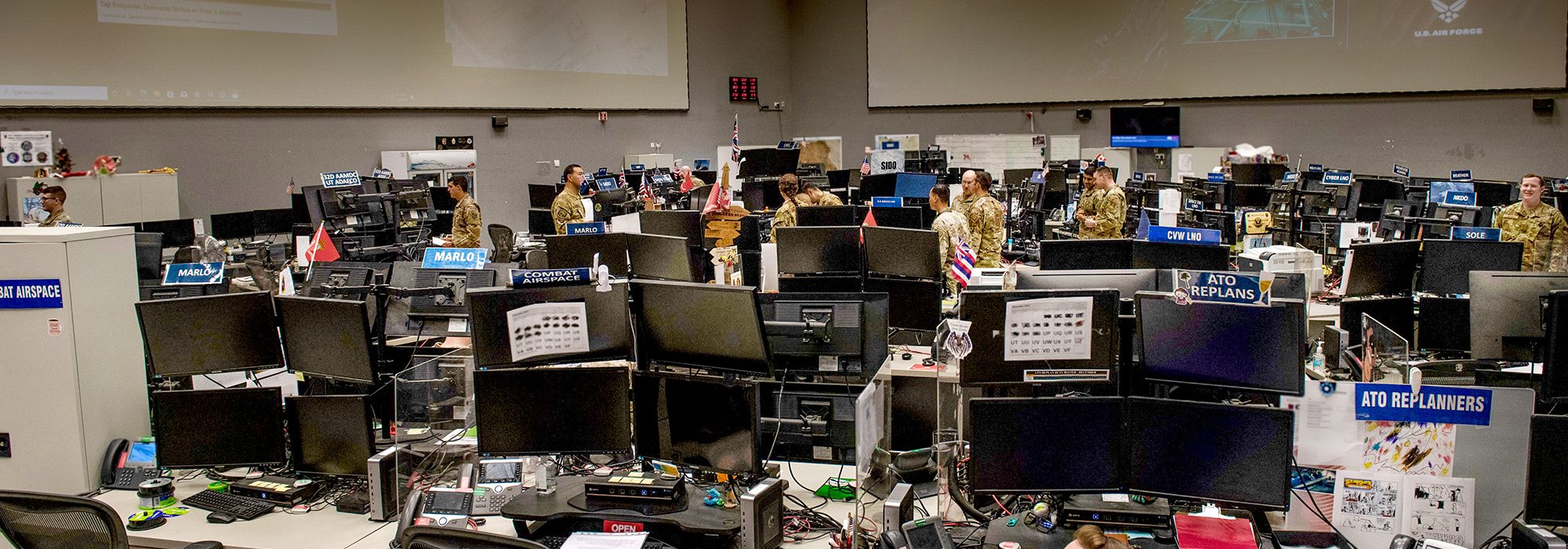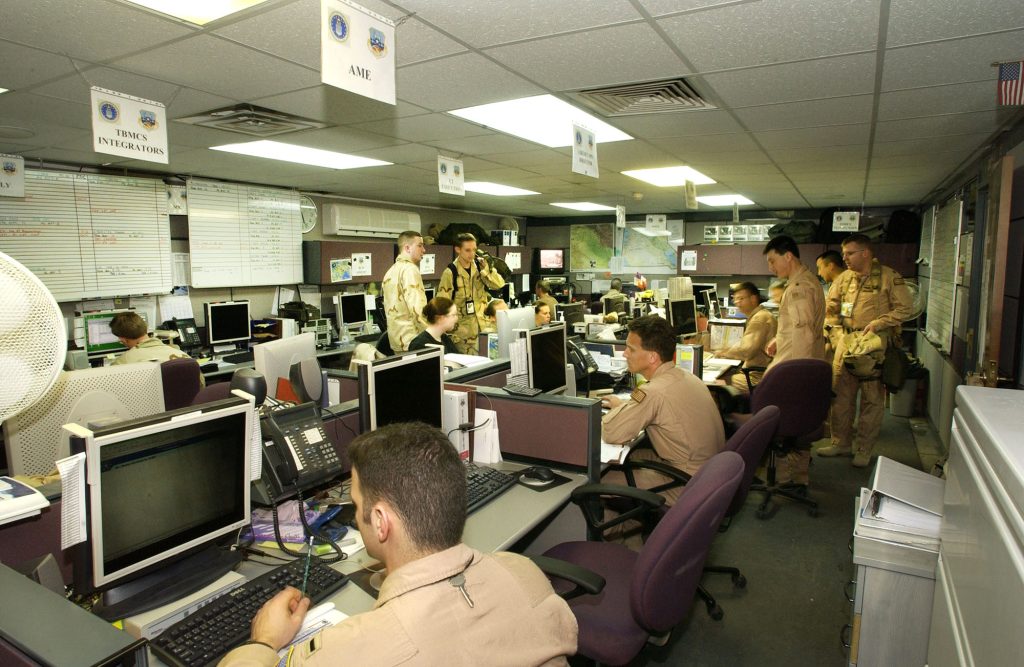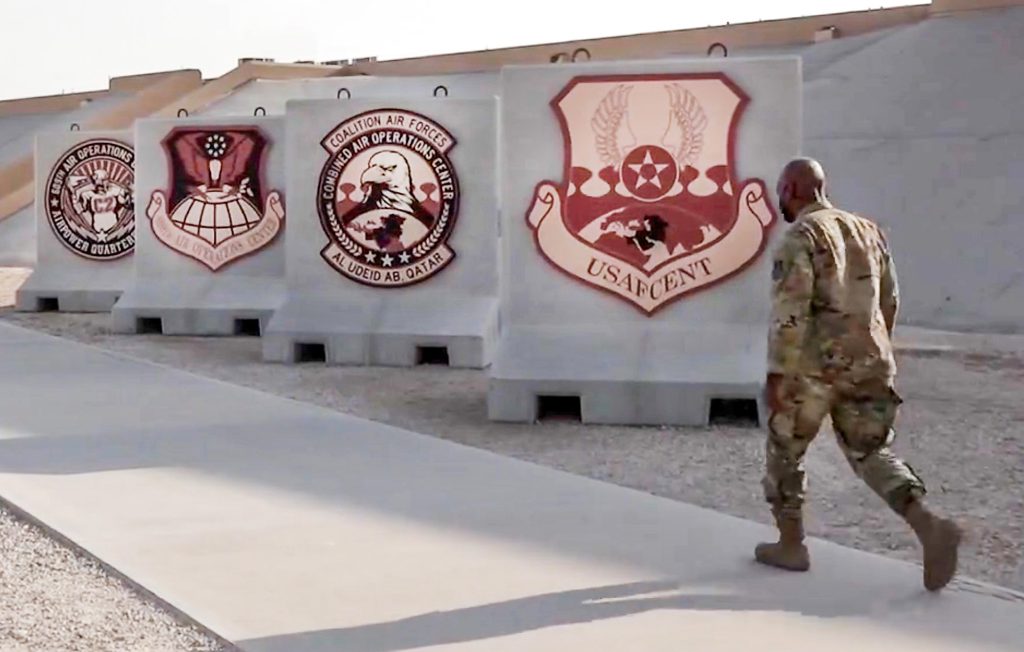How the Air Force knocks down threats and builds stronger teams in the world’s most complicated air operations center, the CAOC at Al Udeid.
AL UDEID AIR BASE, QATAR
A speedboat loaded with explosives barrels toward commercial shipping lanes on video screens as Airmen gather around to watch in the theater-sized command center at this desert base 45 minutes from downtown Doha.
The vessel, unmanned and festooned with antennas, is on a remote-controlled one-way mission to attack maritime commerce. The Airmen here are doing everything they can to make sure that doesn’t happen, following a live video feed from an MQ-9 Reaper drone approaching the target.
It’s not easy, but it’s quick: Within 15 minutes of being alerted to the threat, the Reaper finally locks onto its target and the game is over. Airmen remotely fire a Hellfire missile, which is unleashed with a puff of white smoke, followed moments later by a flash of light as the missile detonates, momentarily whiting-out screens on the computer terminals.
It’s just an ordinary day here at the Combined Air Operations Center (CAOC).
Air Forces Central Commander Lt. Gen. Alexus GrynkewichOne of the things that the United States Air Force … does better than most is that we deliver operational-level command and control capability.
The CAOC is the Air Force nerve center in the Middle East, responsible for planning and executing air operations across the U.S. Central Command (CENTCOM) area of operations, which spans from the Red Sea to the Turkish border and from Syria to Afghanistan. Although political leaders have sought for a decade or more to tilt their attention more to the Pacific, CENTCOM and the CAOC remain the busiest of commands in one of the most complex regions of the world. Air & Space Forces Magazine was granted unusual access to the CAOC in action in early February.
Since Hamas’ surprise Oct. 7 raids in Israel, the command center has overseen airstrikes against Iranian-backed militias in Syria, Iraq, and Yemen, where crewed aircraft, drones, and Tomahawk cruise missiles have been used to punish attackers and deter further aggression in the region. The CAOC continuously monitors militia and Iranian military activity and maintains a wary eye on Russian warplanes operating in Syria, which have displayed a penchant for harassing U.S. aircraft and even troops on the ground.
“One of the things that the United States Air Force … does better than most is that we deliver operational-level command and control capability,” Air Forces Central (AFCENT) Commander Lt. Gen. Alexus G. Grynkewich told Air & Space Forces Magazine amid the roar of C-130 propellers as he shuttled between visits to regional allies. The CAOC is at the heart of that.
Grynkewich, who is also the Combined Forces Air Component Commander (CFACC), the top joint air boss in the Middle East, said the CAOC is one of the centers with which the U.S. connects Arab and European partners against the aggressive tendencies of their common adversary—Iran and its partners in the region. Though formally based at Shaw Air Force Base, S.C., Grynkewich spends more than half of his time in the Middle East, working out of the CAOC and hopscotching the region to meet with allies, build cooperation, and assess changing threats.
“Long term in this region, one thing all our partners are concerned about is air and missile defense, particularly with the Iranians having proliferated missiles and UAVs around the region—up in Iraq, in Syria, with the Houthis,” Grynkewich said. “All of these countries recognize the threat that poses.”
Al Udeid, a base on a beige expanse in the Qatari desert, is home not only to the CAOC but also to the forward headquarters for U.S. Central Command. It hosts Air Forces Central, Space Forces Central, and Special Operations Command Central.
DESERT OASIS
Owned by the Qataris, the base has hosted fighters, bombers, mobility aircraft, and tankers over the past quarter century, supporting operations in Afghanistan, Iraq, Syria, and elsewhere in the region. The U.S. and Qatar recently agreed to extend the U.S. lease on the base for another 10 years.
Hosting the formidable U.S. presence is something of a balancing act for Qatar, which also provides sanctuary for Hamas’ political leadership and is home to the headquarters for the Al Jazeera media network.
Within the confines of Al Udeid, however, the host nation politics is put aside and the focus is on the mission. A visit to Al Udeid’s control tower reveals a vast expanse of concrete, living quarters for over 10,000 Airmen and the bunker-like CAOC building, rising out of the desert like an upturned bathtub surrounded by razor wire.
“This location has been a critical nexus of airpower since 2002. But the interest in CENTCOM isn’t where it was when we all first came here two decades ago,” said Brig. Gen. Douglas D. Jackson, commander of the 379th Air Expeditionary Wing, the main unit here that employs some 3,000 Airmen. “Sometimes Al Udeid gets this reputation, which is just like this giant, concrete swath that nobody really knows what’s going on.”
After 20 years, however, Al Udeid is now a multibillion-dollar base with numerous hard structures and permanent facilities, a far cry from those days three decades ago when Airmen ran missions out of tents in Saudi Arabia as they planned Operation Desert Storm.
“The original CAOC was built out of tents out in the parking lot behind the Royal Saudi Air Force headquarters in downtown Riyadh,” said retired Lt. Gen. David A. Deptula, a key attack planner for the operation. “We moved into the basement of the Royal Saudi Air Force headquarters where Desert Storm was executed.”
Later, Deptula would be the CAOC director during the opening months of Operation Enduring Freedom in Afghanistan.
For years, the Air Force sought to improve on the humble arrangements, finally achieving a breakthrough when Gen. Charles Wald, then the AFCENT commander, secured access to a new command center at Prince Sultan Air Base near the Saudi capital. Dubbed Falconer, the command center was completed just a few months before the Sept. 11, 2001, terrorist attacks, and was used to run the air war in Afghanistan and, a year and a half later, to run the air operations for the invasion of Iraq in 2003.
Shortly after Saddam Hussein was toppled, the CAOC was moved to Al Udeid to a $60 million facility, fed by 67 miles of high-capacity fiber-optic cable. The CAOC got a $3 million upgrade in 2020.

With so much invested and at stake here, Al Udeid is well defended. An array of Patriot anti-missile batteries protect the base and its occupants, an understandable precaution given Iran’s ballistic 2020 missile attack on U.S. forces at Al Asad Air Base in Iraq and its 2019 cruise missile and drone attacks on Saudi oil facilities at Abqaiq.
The CAOC—despite being a possible target itself—coordinates air defense for the entire region. Yet no location is invulnerable, which is why then-CENTCOM Commander Gen. Kenneth F. McKenzie in 2019 ordered that a duplicate facility be constructed at Shaw far from harm’s way, and able to take over at a moment’s notice if necessary.
PROVING GROUND
Over two decades of military operations in the region, the CAOC has served as a proving ground for Air Force leaders and introduced several innovations.
Retired Gen. Jeffrey L. Harrigian was AFCENT commander from 2016 to 2018. During his tenure, he leveraged DIUx and Pivotal Labs software experts to digitize the CAOC’s tanker mission planning, converting it from a human-powered whiteboard system to a largely automated computer application.
AFCENT has a level of control over its network that is unique in the Air Force. That gives the commander “some increased flexibility to get after the key problems inside the AOC,” Harrigian said.
“We were building applications to make the job easier for our Airmen,”Harrigian added. “When we had a new app or wanted to change some part of our network architecture … because we ‘owned’ the network, I was able approve it and have them move out. I don’t think there’s anybody else in the Air Force that can do that.” Harrigian built on the work of his predecessor, Gen. Charles Q. Brown Jr., who led AFCENT from 2015 to 2016, turning the tide against ISIS, and went on to become Air Force Chief of Staff and now Chairman of the Joint Chiefs of Staff.
Then-Air Force Maj. Gen. B. Chance Saltzman—now the four-star Chief of Space Operations—was the deputy commander at AFCENT when the backup CAOC stood up at Shaw.
And Brown’s predecessor as Air Chief, Gen. David L. Goldfein, who commanded AFCENT from 2011 to 2013, drove the expansion of the CAOC to include representatives from the Gulf Cooperation Council (GCC) countries—Bahrain, Kuwait, Oman, Qatar, Saudi Arabia, and the United Arab Emirates.
“I assessed that we needed to raise a generation of officers that understood the essence of integrated air and missile defense and the C2 needed to execute a defense of the Arabian Gulf,” Goldfein told Air & Space Forces Magazine. “The vision was to create a cadre of young officers who had a common experience at the CAOC who could go back to their operational headquarters and help improve our interoperability.”
That work opened Goldfein’s imagination to wider possibilities, he said. Indeed, “It was this experience that became the foundation of my argument for what became JADC2,” he said, referring to what is now called combined joint all-domain command and control, a Pentagon-wide concept for integrating all domains and all command elements into a seamless, unified whole.
Goldfein worked for Marine Gen. James Mattis during his AFCENT command tour, and Mattis, who would go on to became Secretary of Defense during Goldfein’s time as CSAF, was equally committed to increasing the participation of the United States’ Arab partners in the CAOC.
All that flew in the face of standard practice from just a few years before. “Never in my life did I ever think I’d see some of the GCC partners [willing to work with other nations for] regional stability,” said Col. Julie Sposito-Salceies, now commander of the 609th Air Operations Center, the first woman to hold that command in a socially conservative region.
After Moscow sent Russian warplanes to Syria in 2015, the CAOC took on the challenge of deconfliction, opening up a communications channel with the Russian commanders at Khmeimim Air Base in Syria so the two countries could try to avoid inadvertent clashes, even as Moscow carried out air operations in support of Syrian President Bashar al-Asad and the U.S. military pursued Islamic State militants in the same country. At the start, the channel consisted of nothing more than a phone line backed up by a Gmail account.
UNIQUE DIPLOMACY
Managing the diplomatic sensitivity of information-sharing among such a disparate U.S.-led coalition, however, requires some attention. Giant screens display the hotspots around the region; every partner representative in the command center can see it all, though some more-sensitive information is held more closely and shared only with specific partners. There are 19 nations represented in the Al Udeid CAOC, with 150 embedded partner-nation personnel. Around 300 to 400 personnel are assigned to the 609th Air Operations Center at Al Udeid. Back at Shaw, the U.S. staff is roughly in line with Al Udeid, with about 20 coalition personnel.
The entire operation is joint and international. Indeed, the CAOC is currently directed by a Canadian, and the position will rotate to the British this summer.
“I think it’s a testament to how well it works that they trust a Canadian or a Brit to be the director, and overseeing all of that,” said CAOC Director Royal Canadian Air Force Brig. Gen. Sid Connor.
Of course, sharing data among Five Eyes partners Australia, Canada, New Zealand, the United Kingdom, and the United States is “particularly easy,” Connor said. “It gets a little more challenging as you get away from that. But we do integrate anywhere we can. Any AOC is designed to supply airpower to multiple operations at once. So for any given operation, we’ll have a different group of nations that have decided to participate.”
Recent U.S. air operations in the region have presented challenges to the coalition. In October, a U.S. F-16 shot down a Turkish drone that was threatening American forces in northeast Syria.
AFCENT juggles numerous missions, including its Task Force 99 project, established to explore new ISR, kinetic and electronic warfare options, and its involvement in naval operations, such as when the USS Carney shot down a swarm of Houthi drones on Oct. 19 over the Red Sea. For one three-hour-long engagement on that day, some CAOC personnel earned the Joint Service Commendation Medals for helping take down a dozen drones while having to deconflict airspace. “We’re going after things that we haven’t necessarily seen before, in environments that we don’t have the luxury” of having local boots on the grounds, as the U.S. had in Iraq, Syria, and Afghanistan, said an Air Force intelligence officer. “There are a lot of unknowns.”
THE CAOC IN ACTION
A Feb. 3 operation against Iran-backed militia groups in Syria and Iraq—the largest single set of airstrikes launched in the Middle East during the Biden administration—also showcased the CAOC’s central role.
The mission began half a day earlier, when B-1B Lancers took off from Dyess Air Force Base, Texas, flying over Canada and Europe before joining U.S. Air Force planes based in the Middle East to attack targets in Iraq and Syria. In all, more than 125 precision munitions struck 85 targets as the U.S. retaliated for a deadly drone attack in Jordan that killed three American Soldiers days before.
Radar tracks indicating the progress of the air armada lit up computer screens as Grynkewich and his international battle staff monitored and watched intently. The strike package—the aircraft and munitions—was hand-written on a dry-erase board on the wall inside the Battle Cab, a windowless high-tech command center inside the CAOC, where Grynkewich went through the final checks on video conference with his boss, Army Gen. Michael “Erik” Kurilla, calling in from U.S. Central Command’s headquarters in Tampa, Fla.
A half hour before the action was set to start, a cable news channel reported from Washington that the attack had begun. The media, aware of the bombers’ flight, jumped the gun; the attack was yet to unfold.
Then, precisely at midnight local time, the first of the bombs struck facilities used by Iran’s Islamic Revolutionary Guards Corps and Iraqi militia groups backed by Tehran. The hours of planning and monitoring had reached their climax; now, as targets crumbled, the staff on the command center floor clapped and cheered.
Yet for Grynkewich, the future of the CAOC is something more than a combat operations center. “We want it to become a campaigning headquarters and think more long-term about how to insure and deter in the region,” he said. “At the same time, certainly, since Oct. 7, we realized that we absolutely have to be able to continue to run combat operations—not just as a supporting command to others but being able to do those on our own. I think we’ve seen the fruits of those labors.”


